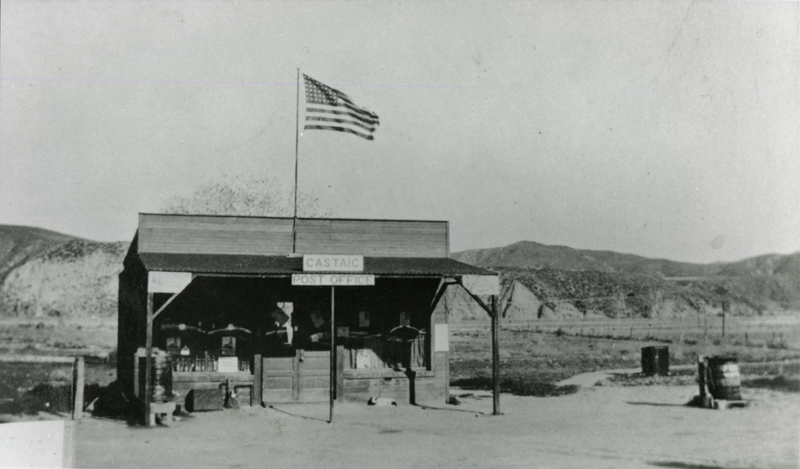|
|
HISTORY OF THE SANTA CLARITA VALLEY BY JERRY REYNOLDS
[NEXT] [PREVIOUS] [CONTENTS] [SEARCH]52. Servicing the Traveler
The Los Angeles Aqueduct and the Ridge Route were designed to get water and motorists through the Santa Clarita Valley as quickly as possible — not to benefit local residents. However, both did stimulate growth, the likes of which had not been seen since the coming of the railroad.
Mulholland's water works up in San Francisquito Canyon employed a number of people who tended the aqueduct and worked in two powerhouses. Bungalows were built in this isolated location, large enough to house whole families who, naturally, shopped in Saugus or Newhall.
While the Ridge Route did not bring many permanent residents, it did cut down on travel time to the great markets of Los Angeles. One could journey to the city and back in a single day — an amazing feat to many old-timers.
There was an increasing number of gentlemen clad in long linen dusters with goggles over their eyes, piloting chugging, spitting vehicles with names such as Maron "41," Winton "Six," or Packard ("Ask the man who owns one"). Their families might get hungry along the way, or they might need gasoline or repairs. So began a series of what could be called tourist traps.
Jesse Doty opened his Ford garage facing Spruce Street (now San Fernando Road) in 1914. Doty was one of several merchants to set up shop on Spruce when real estate prices on Newhall's former main street, Railroad, became too dear in the years before World War I.
Way ahead of his time, Doty employed two attractive young ladies, Margie Smith and Nell Bailey, to act as "service station attendants." From a hundred-gallon barrel in the back room, gasoline was drawn in buckets to be funneled into waiting car tanks. The price? An outrageous ten cents a gallon. But what could one do? This was an isolated location. Two years later Carl Sischo acquired the corner of Eighth Street and Spruce and opened the first true gas station in the valley.
Not to be outdone was Fred Lamkin, who arrived in Newhall with his family in 1917. Lamkin set up his "Newhall Garage" on Spruce Street and sold Chevrolets, rivaling Doty's Ford dealership. Although they changed hands over the years, the Ford and Chevrolet dealerships were fixtures in downtown Newhall until the late 1970s, when they moved into the new Valencia Auto Center. Currently they are known as Power Ford and Power Chevrolet, both owned by AutoNation.
Albert C. Swall arrived in Newhall from Tracy, California at the age of nineteen and leased the meat department in James A. Gulley's general store on Railroad Avenue. He soon owned the whole shop and set out to buy as much of the rest of Newhall's business section as he could. In 1914 he built the two-story, brick Swall Hotel at the corner of Spruce and Market streets — roughly the same spot where the Southern Hotel had stood some three decades earlier. There he installed electric lights, to the general wonder of the local populace. (The Swall Hotel, later known as Newhall Pharmacy, was heavily damaged in the February 9, 1971 Sylmar Earthquake. When it was rebuilt, its bricks were replaced with Spanish stucco.)
Swall also invested in Saugus, where he opened a general store about 1911. Martin Wood expanded his Saugus Cafe in 1916, while his brother Richard switched his enterprise from a blacksmith shop to an auto repair emporium known as Wood's Garage.

Sam Parson's Castaic general store.The next stop up the Ridge Route for the weary early motorist was Castaic, where Sam Parson managed to get a post office established in his general store on April 3, 1917. Two years later he sold out to Anthony H. Schuyler, who added a gas station to his shop. At the same time Burt Reynolds — not that Burt Reynolds — opened the Evergreen Motel next door, followed by a campground.
On the way up, there was the Ridge Road Garage, the Tumble Inn, Reservoir Summit and that splendid establishment in the wilderness known as Sandberg (or Sandbergs). Local rancher Herman Sandberg provided excellent steaks at his hotel, guaranteed fresh. Slot machines could also be found there, and in a long, low building out back known as "The Crib," feminine companionship was available to weary truckers and lonely salesmen.
As far as is known, the very first locally-owned horseless carriage was purchased in 1908 — not by some adventurous man, but by a charming, hard-working widow named Frances Delano Phillips. After her husband Harry died, she opened a rooming house and cafe, served on the school board and PTA, and went first-class when she bought her car.
It was a Cadillac.
©1998 SANTA CLARITA VALLEY HISTORICAL SOCIETY • RIGHTS RESERVED.
The site owner makes no assertions as to ownership of any original copyrights to digitized images. However, these images are intended for Personal or Research use only. Any other kind of use, including but not limited to commercial or scholarly publication in any medium or format, public exhibition, or use online or in a web site, may be subject to additional restrictions including but not limited to the copyrights held by parties other than the site owner. USERS ARE SOLELY RESPONSIBLE for determining the existence of such rights and for obtaining any permissions and/or paying associated fees necessary for the proposed use.